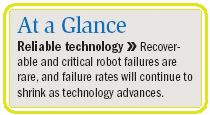Article
Robot failure during radical prostatectomies is 'extremely rare'
Researchers surveyed nine high-volume institutions that use the da Vinci surgical robot (Intuitive Surgical, Sunnyvale, CA) and learned that the failure rate for these devices during prostatectomies was 0.3%.

Vipul R. Patel, MD, director of robotic and minimally invasive urologic surgery at the center, surveyed nine high-volume institutions that use the da Vinci surgical robot (Intuitive Surgical, Sunnyvale, CA) and learned that the failure rate for these devices during prostatectomies was 0.3%.
"Critical malfunction during surgery is extremely rare," Dr. Patel told Urology Times at the AUA annual meeting. "I think the take-home message is that robots have now become another tool in the urologist's armamentarium. The technology is expanding around the world, and is showing excellent results."
"We decided to look at only the top institutions, those that do a critical mass of procedures that really test the machine. Rather than doing a prostatectomy once or twice a month, these surgeons are using the robot every day. If it is going to break, it is going to break at one of these institutions," he said.

The study team recorded critical failures in 20 cases (0.3%) leading to the cancellation of 10 procedures and conversion to laparoscopic in one case and to open procedure in nine cases. Recoverable failures were more frequent, occurring in 124 instances (1.9%). The most common malfunctions or failures occurred in the optical system and in the surgical arms. Failure of the master system or power system was less common.
"The reason we conducted this study is that there is no literature out there on the incidence of malfunction," Dr. Patel said, noting that the survey was instituted to benefit both surgeons and patients.
"After I explained the procedure, some of my patients would ask, 'What are the chances of this thing breaking? What happens then?' " he said.
Dr. Patel can now tell them that the chances of a failure requiring cancellation of the procedure or conversion to another one are less than slim. The Ohio State Medical Center has three robots, and Dr. Patel anticipates that in the event of a failure, the availability of a second robot would obviate the need to cancel a procedure or to convert to open. He suspects the situation is similar in other major institutions.
Future is bright
Dr. Patel also said that the data are reassuring as the technology advances. The instrumentation is becoming smaller and more facile, and more important, the optics are improving. One of the major advantages of surgical robotics is the clear vision they offer of the operating field.
Advances to be anticipated are the wedding of external imaging systems, such as MRI, CT, and ultrasound, to images provided by the robotic system. Dr. Patel predicted that in the approaching future, at least half of all prostatectomies would be conducted with robotic systems.
The first robot-assisted procedure, a cholecystectomy, was performed in 1987. The da Vinci Surgical System was approved in 2000, and it is estimated that more than 210 such systems are in use in the United States, Europe, and Japan.





